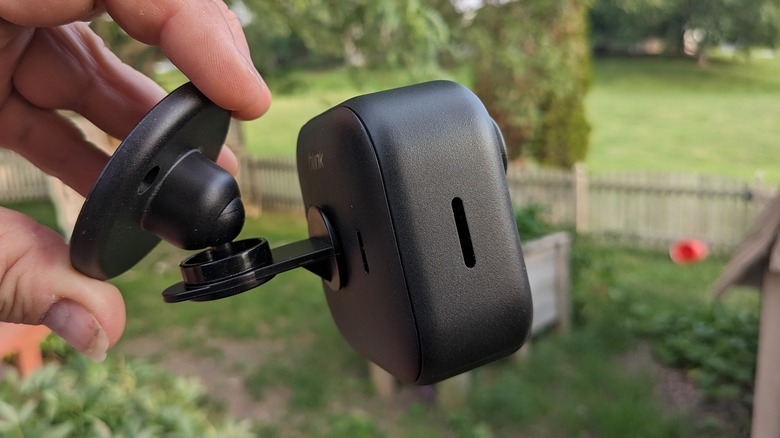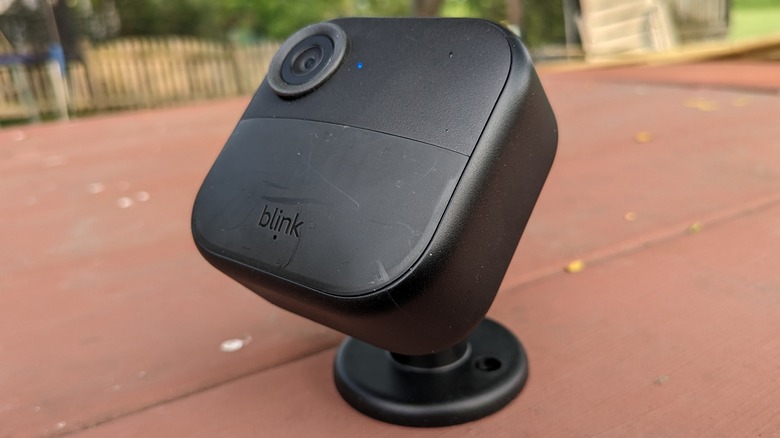Blink Outdoor 4 Camera Review: Cheap And Wireless With A Shocking Battery Boast
- Extremely versatile
- Two year battery life is impressive (if it's real)
- Solid build quality on the camera
- App is straightforward
- Camera accessories have questionable durability
- MicroUSB in 2023
- No continuous recording capability
We may receive a commission on purchases made from links.
Home security is a great first step toward making your home smart. Cameras that connect to Wi-Fi are especially handy because they allow you to keep an eye on things when you're not around. Things get tricky, however, when you take power into account. It's bad enough when you have to make sure you're in Wi-Fi range, but you often also have to figure out how you're going to power your device. As a result, you either are forced to replace a wall sconce that is wired like with the Blink Wired Floodlight camera, opt for solar power like the S330 eufyCam 3, or you have to deal with batteries and charging like the Wyze Cam Outdoor.
But what if you didn't? What if you had a camera that you could put basically anywhere and not have to worry about power for a whole two years? That's the value proposition that Blink is going for with the Blink Outdoor 4 camera, and which the company says can last for two years on a single charge with the default settings. What's more, that charge comes from a regular set of two AA lithium batteries, that are included in the box.
I've been testing this camera for one week in and around my home, through a heat wave in Chicago, and here's what I've found.
The sum of all its parts
The Blink Outdoor 4 camera comes with several components. You'll get the Outdoor Camera 4 itself, a Blink Sync Module 2, and mounting hardware, the first of which is a plastic pedestal that slots into the back of the camera for mounting on a wall, and a second plastic arm that slots into the pedestal and then into the back of the camera for mounting on a horizontal surface (as shown above). The pedestal can point in any direction up to about a 45-degree offset and the parts are all interchangeable, so it's very versatile. You can point the camera anywhere it needs to go, but the pedestal and the arm are both made with cheap-feeling plastic that may or may not be durable in temperature extremes. That being said, we confirmed with Blink that the camera and the mounting hardware were both tested between -4 and 113 degrees Fahrenheit.
The camera itself measures 70 x 70 x 41 mm, with a flat base so that it can sit just about anywhere, mount attached or not. If you choose not to mount it, you can set it down anywhere where it gets a signal from Wi-Fi and the Sync Module, like your back yard to watch your dogs, your front yard to watch for deliveries, or your kitchen table to find out which of those dogs couldn't wait until morning to go outside.
In addition to the camera sensor, there's also a speaker for speaking to your guests, an infrared light for night vision, and an LED light to indicate when recording is happening. On the back is a large flathead screw to open the camera and a rubber plug to cover the USB Type-C port you can use to pull videos off the camera.
Old-school Sync module 2
The other device in the box is the Sync Module 2. This has been a Blink staple for some time now and it does what its name suggests: syncs your camera's images to the cloud. It's a small box that needs constant power, such as from the included microUSB cable. Yes, you read that right: microUSB is still a thing in 2023.
According to Blink, the sync module is part of the secret sauce that helps the Outdoor Camera 4 achieve a two-year battery life. The camera communicates with the module using Amazon's proprietary communications protocol, good for up to 100 feet. Additionally, the sync module takes on the role of the uploader, freeing up the camera from having to establish a connection and upload the files. Regardless of how slow your internet connection might be, the sync module will handle that load.
The Sync module also has a USB-A port for a memory stick, meaning you can opt for local storage rather than relying on the cloud. Finally, being connected to the Sync Module 2 allows the Blink outdoor camera to go to sleep when not in use. When you open up the camera to stream the view, he Sync Module 2 sends a signal to wake the camera up.
Same old Blink app
You can connect to the camera using the Blink app, and it's a fully functional camera in every way. Those "default settings" are key to the longevity though. By default, your viewing time is set to just five seconds, notifications are turned off, video quality is set to "Standard", and IR intensity is set to "low".
You can enable alerts for movement, and you can choose between any movement or actual person detection. Detection zones and privacy zones are also supported. The latter of those actually blocks out an area so that nothing is captured there, which could make your neighbors happy if they don't want to appear on camera.
To see what the camera sees in the app, you simply tap the video camera or the camera icon—the former shows you the five seconds it can stream before asking you to continue, while the latter just captures a snapshot of what's happening right now. As mentioned before, you can adjust the live stream for longer if you want.
The sync module meanwhile uploads all its captured footage to the cloud or stores it on a USB drive if one is inserted. You can't scrub through past footage, but the vault stores clips of all the movement that is detected, so you'll only miss the boring parts when nothing happens, which isn't so bad.
Picture and sound
Blink uses a 1080p sensor in the upper left corner of the camera, and at the default settings the picture quality is pretty good with a decent field of view. There's little compensation for the fisheye effect a wide-angle lens returns, which is not ideal. However, you can identify faces from as far away as 30 feet.
At night, the IR light adequately covers the whole field of view and gives you a decent picture. There is no spotlight, of course, so you're limited to what the IR lens can capture: about 15-20 feet of decent detail until it falls apart, especially where faces are concerned.
As for sound, there's two-way communication: the microphone is great for picking up sound but the speakers are a little bit on the quiet side. Also, under the best of conditions, there is about a five-second delay between the camera seeing or hearing anything, and you seeing and hearing it through the app. That can make communication challenging, so keep that in mind if you decide to engage in conversation with a passing burglar.
Battery life
As for battery life, that's hard to say. One of the downsides of advertising two years of battery life is that it takes two years to find out if the claim is true. All I can tell you about the battery life is that on the first day, the battery was reported as "OK" in the app, and on the last day of testing it was still "OK". That's reassuring, but not terribly diagnostic.
In the world of outdoor security cameras, it's a good idea to take any kind of battery life claims with a healthy dose of salt. Plenty of factors — beyond just Blink's default settings — impact power consumption, particularly things like large temperature swings between the seasons. In Chicago, where I tested the Blink Outdoor 4, for example, summer can get up to around 100 degrees Fahrenheit (or in some cases higher) and down to around -15 degrees in the winter (or in a lot of cases, colder). Given those extremes, it's anyone's guess how long the battery will actually last.
Still, a set of lithium AA batteries costs $14.18 for a four-pack. That's not a huge price to pay, though rechargeable batteries are usually preferred. So, even if you don't get a full two years, at least it's not terribly expensive to replace them.
Blink Outdoor 4 camera verdict
All told this is a fairly inexpensive camera that makes for-now-untestable claims about battery life, but is otherwise a very solid offering in a crowded space. At $119.99, it's one of the less expensive options out there, and if the battery boasts are even half true, or a quarter true, that's a small price to pay for being able to set up this camera pretty much anywhere and record what's happening around your home.
Picture quality is good, if only 1080p when rival cameras are already delivering 4K, and it even includes night vision (which is admittedly table stakes at this point). Other security cameras do better at ironing out the fisheye effect of their wide-angle lenses, too. Blink's design is undoubtedly versatile, though, and add-on cameras — which don't come with the Sync Module — are just $109.99.
Still, you're gambling on a promise that it will take you months — or more — to validate, not to mention put you well outside of the return window. Even lasting a year on a couple of AA batteries wouldn't be disappointing, but it's worth remembering that you're living with fairly draconian settings (like no continuous recording) to achieve that. For those who can't do solar or hard-wiring, the Blink Outdoor 4's ability to cut the cord is certainly convenient, but its biggest claim is something only time will convince us on.








